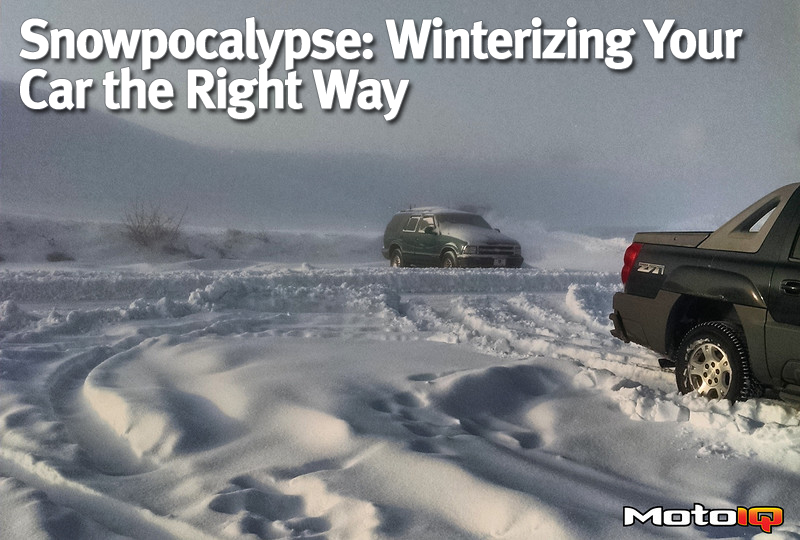,
 We replaced the marker lights in our VehiCross with LEDs for better visibility to other drivers. We also upgraded our headlight bulbs to Silverstar Ultimate. Silverstar claims the bulbs shine brighter and further than normal bulbs. We didn't notice much of a difference, The passenger (left) light has been changed while the driver's side is original. It is a bit brighter, but this didn't really translate into longer range on the road.
We replaced the marker lights in our VehiCross with LEDs for better visibility to other drivers. We also upgraded our headlight bulbs to Silverstar Ultimate. Silverstar claims the bulbs shine brighter and further than normal bulbs. We didn't notice much of a difference, The passenger (left) light has been changed while the driver's side is original. It is a bit brighter, but this didn't really translate into longer range on the road.Step 4: Grab the WD-40. Frozen locks are a common occurrence in the winter. A little bit of water or snow gets into the mechanism, it freezes, and then you’re stuck outside your car. WD-40 is a water displacer (that’s what the WD stands for) as well as a lubricant, so spraying a bit into your locks and working it in with your key will not only lubricate your lock, but help prevent water from getting in and freezing the mechanism in the first place. It’s also a good idea to spray some on your door seals. Door seals can freeze as well, freezing your door shut. Once again, spray down and wipe the WD-40 into the rubber. Yes, your car will smell a bit like WD-40, but it’s better than being stranded outside!

Side note: if your door DOES freeze itself shut, use some warm water to melt the ice by carefully pouring it along the seam of the door. Make sure it is WARM and NOT hot!!! You should be able to easily put your hand in the water. Any hotter and you risk cracking or shattering your door glass. Also, make sure you immediately open your door or it’ll refreeze even worse than before!
Step 5: Arm your trunk. There are a few things any winter driver should keep handy. The first is a good ice scraper. Driving around with ice on your windshield and windows is very dangerous for yourself. Scraping your roof, hood and trunk of snow is a common courtesy and will keep the roads safer for others. If you’re a selfish jerk who hates the human race, just remember that you CAN be held liable if a piece of frozen snow damages another car or injures someone because you were too lazy to clean it off before you left. Next, pick up a small snow shovel. If you park in a parking lot there is a good chance you can get snowed in when the plow goes by, leaving a berm to drive over. A small shovel will make quick work of this berm. It will also give you a way of making a clear path to your car so you can easily enter or exit. If you do get stuck on the road, a small shovel can usually help you dig your way free. Next, carry at least one of the following: some cat litter, some sand, some road salt, or a piece of old carpet. Any of these will add traction to your driving wheels, helping you get out of parking spots, or up hills. Use whatever is most convenient to you. Be forewarned, carpet will have to go back into your car wet (and you’ll have to pick it up too, adding to the possibility of getting stuck again) and cat litter/sand/salt can get everywhere, especially if you don’t use a sealable container.
Next, buy a tow strap. This tow strap is $13 from Harbor Freight and occasionally goes on sale for $10. It is only rated to 2800 lbs which probably won’t be enough to lift your car with a crane, but should be plenty to give most cars a gentle tug free from an embankment. If you’re feeling rich, plenty of off-road shops sell heavy duty straps and some even sell bungee straps that use the power of elastic rope to give firm but gentle pulls on a stuck car. If you live in an area with snowfalls of over a foot, then invest in one of the better ropes. Finally, toss in a pair of dishwashing gloves. You can usually pull these over normal gloves and you and you won’t care if they get wet, dirty, or ripped up. Best of all, a pack of 5 pairs is only a couple dollars at your local grocery store.

Step 6: Fluids. Modern gas, oil, and antifreeze is quite good at its job and usually works very well in all seasons. However if you have an older car, it may be a good idea to do a bit of flushing. Adding a bit of extra antifreeze to your cooling system is not a bad idea. Usually you want a 50/50 mix, but a 55/45 mix will help keep your coolant system from developing any hard spots. Obviously when it’s 30 or below outside, you’re not worrying about cooling capacity. Be sure to drain a bit of coolant and add pure water when the weather warms up again. It can be prudent to use thinner oil as well. Cold oil is more like a sludge than a lubricating liquid and can cause all sorts of damage on startup. Going from 10W-30 to 5W-30 will certainly help your engine turn over in the morning. While bearing damage is unlikely (but possible), you’re more likely to burn out your starter cranking the stiff engine. This will also put more of a load on your battery which can burn it out (or just prevent your engine from starting as the charge drains too low before the engine can catch). While warming up for 4 or 5 minutes before setting off is unnecessary, letting your engine warm up for 30-60 seconds will definitely help your oil thin out, preventing internal damage.

The Final Step: Use your head. This sounds like common sense, but you see it all the time: Many people forget to winterize their car until the day before, or even in the middle of, a big snowstorm. The time to prepare is long before the snow falls, when the weather is turning cold, but not yet frigid. Get yourself into the shop early and when winter does arrive, you can face it with confidence. Leave earlier for work. SLOW DOWN. Keeping control of your car will save you far more time than going fast, sliding off the road, and getting stuck in a ditch (last year I saw not one, but TWO cars on their roofs). Remember, the loosest nut in a car is the one behind the wheel. Driving in snow is not difficult if you practice and pay attention to the road and what your car is telling you. Ice, snow, and slush will all greatly reduce your traction, so plan ahead, leave lots of room, and make sure you have an escape route if the person ahead of you goofs. Be aware of black ice.




